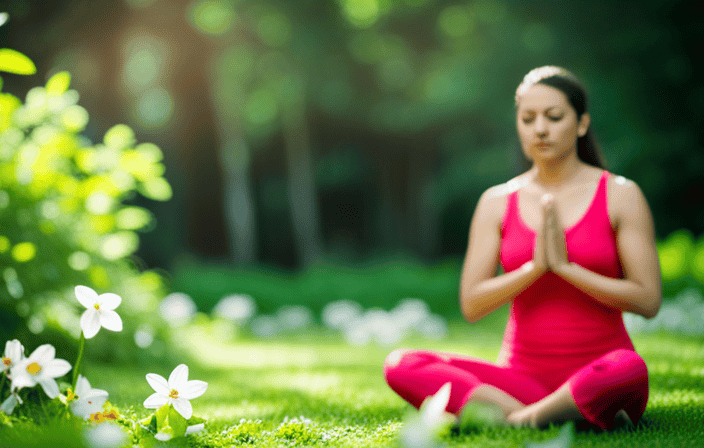Mindfulness
Meditation For Anxiety: Unlocking Inner Peace

Achieving inner tranquility and diminishing anxiety is possible through meditation practices. By adopting Mindfulness-Based Stress Reduction (MBSR) methods, people can alter their brain connections, leading to a notable reduction in symptoms of anxiety.
Meditation also aids in combating depression, improving emotional regulation, and managing triggering thoughts. Through various types of meditation, such as guided meditation, mindfulness meditation, mantra meditation, yoga, and transcendental meditation, individuals can alleviate anxiety and promote overall well-being.
Additionally, meditation provides relief from physical health conditions and enhances mental health. In this article, we explore the benefits of meditation, the science behind it, different techniques, and additional health benefits.
Key Takeaways
- Meditation, specifically mindfulness-based stress reduction (MBSR), has been shown to have physical and mental health benefits, including the reprogramming of neural pathways and effectiveness in fighting depression.
- Practicing meditation can help increase awareness of mental and physical states, reduce fatigue and stress, aid in insomnia and chronic anxiety, and help understand and manage triggering thoughts.
- Meditation works for anxiety by using techniques such as biofeedback and mindfulness-based therapy, deep breathing to stimulate the parasympathetic nervous system, boosting oxygen supply to the brain for calmness, and promoting a connection with the body and a quieting of the mind.
- Different types of meditation, such as guided meditation, mindfulness meditation, mantra meditation, yoga, and transcendental meditation, can provide anxiety relief and offer various approaches to finding inner peace.
Benefits of Meditation
The practice of meditation has been shown to provide numerous benefits, such as relieving tension headaches, managing conditions like high blood pressure and asthma, alleviating chronic pain and irritable bowel syndrome, improving mental health conditions like depression, and enhancing overall well-being and balance.
One of the key benefits of meditation is its ability to relieve stress and promote relaxation. Through mindfulness and deep breathing techniques, meditation helps individuals to calm their minds and bodies, reducing the physiological effects of stress.
By focusing on the present moment and letting go of racing thoughts, meditation allows individuals to find inner peace and a sense of calm. This practice enhances self-awareness and helps individuals to develop a greater sense of control over their emotions and reactions.
By incorporating meditation into their daily routine, individuals can experience a reduction in stress levels and a greater overall sense of well-being.
Science and Evidence
Scientific research and empirical evidence have established a compelling connection between the practice of mindfulness-based stress reduction programs and an array of positive outcomes for individuals grappling with symptoms of anxiety. Numerous scientific studies have been conducted to investigate the efficacy of meditation in reducing anxiety and its associated symptoms. Research findings consistently demonstrate that regular meditation practice can lead to significant reductions in anxiety levels and improvements in overall mental well-being. For instance, a study published in the Journal of Clinical Psychology showed that participants who underwent a mindfulness-based stress reduction program experienced a significant decrease in anxiety symptoms compared to those in a control group. Another study published in the Journal of Alternative and Complementary Medicine found that meditation practice was effective in reducing symptoms of anxiety disorders. These findings highlight the potential of meditation as a valuable tool for managing anxiety and promoting inner peace.
| Study | Findings |
|---|---|
| Journal of Clinical Psychology | Significant decrease in anxiety symptoms in participants who underwent mindfulness-based stress reduction program |
| Journal of Alternative and Complementary Medicine | Meditation practice effective in reducing symptoms of anxiety disorders |
Practicing Meditation Techniques
Practicing various techniques can contribute to managing and alleviating symptoms associated with anxiety.
Mindfulness techniques and meditation techniques for beginners can be effective tools for individuals seeking relief from anxiety.
Mindfulness meditation involves focusing attention on the present moment, cultivating awareness of one’s thoughts, feelings, and bodily sensations without judgment. This practice helps individuals become more attuned to their internal experiences and develop a greater sense of control over their anxiety.
Additionally, meditation techniques for beginners, such as deep breathing exercises and guided imagery, can help individuals relax their bodies and minds, reducing stress and anxiety.
By incorporating these techniques into their daily routine, individuals can develop a greater sense of inner peace and well-being, ultimately leading to a reduction in anxiety symptoms.
Understanding Triggering Thoughts
Understanding the insidious nature of triggering thoughts requires a keen awareness of the intricate ways in which our subconscious mind weaves intricate narratives that perpetuate anxiety-inducing patterns. Cognitive reframing is a powerful technique that allows individuals to challenge and change negative thought patterns, ultimately reducing anxiety.
By identifying and questioning the validity of these triggering thoughts, individuals can gain a new perspective and reframe them in a more positive and realistic light. This process helps manage negative emotions by breaking the cycle of anxious thoughts and allowing for a more balanced and rational response.
Additionally, practicing meditation can enhance emotional regulation and provide a sense of inner peace, further supporting the management of triggering thoughts. Through consistent meditation practice, individuals can develop the skills to recognize and address these thoughts, leading to a healthier mindset and a reduction in anxiety.
How Meditation Works
By cultivating a focused and relaxed state of mind, individuals can develop a greater sense of clarity and emotional well-being, facilitating the process of managing triggering thoughts and reducing anxiety.
One of the ways meditation works to alleviate anxiety is through deep breathing techniques. Deep breathing stimulates the parasympathetic nervous system, which helps activate the body’s relaxation response and counteract the stress response. By consciously slowing down and deepening their breath, individuals can signal to their body that they are safe and calm, promoting a sense of peace and tranquility.
Additionally, meditation can incorporate biofeedback therapy, which involves using technology to monitor and provide feedback on physiological indicators of stress, such as heart rate and muscle tension. This feedback can help individuals become more aware of their body’s response to stress and learn to consciously regulate their physiological and emotional state, leading to a reduction in anxiety.
Types of Meditation
Different types of meditation, such as guided meditation, mindfulness meditation, mantra meditation, yoga, and transcendental meditation, offer various techniques and approaches for individuals seeking relief from anxiety.
Guided meditation involves visualization techniques, where a trained instructor or audio recording guides individuals through calming and peaceful imagery. This type of meditation helps redirect the mind away from anxious thoughts and creates a sense of relaxation.
Mindfulness meditation focuses on living in the present moment and cultivating awareness of one’s thoughts, emotions, and bodily sensations. By practicing mindfulness, individuals can observe their anxiety without judgment and develop a more accepting and compassionate relationship with their inner experiences.
Mantra meditation involves repeating calming thoughts or phrases, which can help divert attention from anxious thoughts and induce a relaxed state.
Yoga combines controlled breathing and postures to promote physical and mental well-being, making it an effective practice for reducing anxiety.
Transcendental meditation involves repeating assigned mantras, which helps individuals achieve a state of deep relaxation and inner peace.
Incorporating these different types of meditation into one’s routine can provide individuals with a range of tools and techniques to manage and alleviate anxiety.
Additional Health Benefits
Enhancing overall well-being and balance, meditation has been found to have a positive impact on various health conditions, including tension headaches, sleep problems, high blood pressure, asthma, chronic pain, irritable bowel syndrome, and mental health conditions like depression.
In addition to its ability to reduce anxiety, meditation has been shown to alleviate physical ailments and promote emotional well-being. The practice of meditation allows individuals to cultivate a sense of calm and relaxation, which can help relieve tension headaches and improve sleep quality. Furthermore, research has demonstrated that regular meditation practice can lower blood pressure levels and improve respiratory function, making it beneficial for individuals with high blood pressure and asthma.
Moreover, meditation has been found to be effective in managing chronic pain and irritable bowel syndrome. By promoting relaxation and reducing stress, meditation can alleviate symptoms associated with these conditions. Additionally, studies have shown that meditation can have a positive impact on mental health, particularly in reducing symptoms of depression.
To further illustrate the health benefits of meditation, the following table provides a summary of the conditions that can be relieved or improved through regular meditation practice:
| Physical Ailments | Emotional Well-being |
|---|---|
| Tension headaches | Reduced stress |
| Sleep problems | Improved mood |
| High blood pressure | Enhanced emotional regulation |
| Asthma | Reduced symptoms of depression |
| Chronic pain | Increased overall well-being |
In conclusion, meditation offers a holistic approach to improving both physical and emotional health. By incorporating this practice into daily life, individuals can experience relief from various physical ailments and promote emotional well-being.
Regular meditation practice has been shown to have a positive impact on various health conditions. These include tension headaches, sleep problems, high blood pressure, asthma, chronic pain, irritable bowel syndrome, and mental health conditions like depression.
For individuals who are new to meditation, there are several techniques that can be helpful in getting started. Guided meditation, which involves visualization or guided imagery, can provide a structured approach for beginners. Mindfulness meditation, focusing on living in the present moment, can help cultivate awareness and reduce anxiety. Mantra meditation, which involves repeating calming thoughts or phrases, can provide a focal point for the mind.
Incorporating meditation into one’s daily routine can be achieved by setting aside a specific time each day, creating a dedicated meditation space, and gradually increasing the duration of practice.
By incorporating meditation into their daily routine, individuals can unlock inner peace and experience the numerous benefits it offers.
Frequently Asked Questions
Can meditation completely cure anxiety?
While meditation can be a valuable coping mechanism for anxiety, it is unlikely to completely cure the condition. However, meditation techniques such as mindfulness and deep breathing can provide relief and help manage symptoms of anxiety.
How long does it take to see results from meditation for anxiety?
The time it takes to see results from meditation for anxiety varies for each individual. However, even short meditation sessions can provide benefits such as increased relaxation and reduced stress. Techniques to enhance effectiveness include practicing regularly and incorporating deep breathing and mindfulness techniques.
Is it necessary to meditate for long periods of time to experience the benefits for anxiety?
Short meditation sessions can still provide benefits for anxiety. Techniques like deep breathing, mindfulness, and mantra repetition can help manage anxiety during meditation. Consistency and regular practice are key for experiencing the benefits.
Can meditation worsen anxiety symptoms?
While meditation is generally considered beneficial for anxiety, in rare cases it can potentially worsen symptoms. Individuals with severe anxiety or trauma history may find certain meditation techniques triggering. In such cases, alternative practices like gentle movement or relaxation exercises can be explored.
Are there any potential side effects of meditation for anxiety?
While meditation is generally safe, it’s important to be aware of potential risks and take precautions. Some individuals may experience increased anxiety or feel overwhelmed during meditation. It’s advisable to start with shorter sessions and consult a healthcare professional if needed.
Say hello to Cypress, the soulful wordsmith behind the insightful articles at OurMindAndBody.com. Cypress is a gifted writer who weaves words with grace and precision, using language as a powerful tool to inspire, heal, and uplift the spirits of readers.
With a background in literature and a passion for personal growth, Cypress brings a unique perspective to the world of well-being and spirituality. Having experienced the transformative effects of meditation and yoga firsthand, Cypress is deeply connected to the essence of these practices and their potential to enrich lives.
Mindfulness
The Spiritual Significance Of Proper Hair Disposal

Have you ever considered the spiritual significance of properly disposing of hair?
From donating hair as a symbol of letting go of negative energy to burying it for growth and giving back to the earth, different cultures and spiritual traditions have unique beliefs and practices surrounding hair disposal.
This article explores the importance of researching reputable institutions for hair donation, alternative methods of hair disposal, and the spiritual energy that hair holds.
Join me as we delve into the depths of this fascinating topic.
Key Takeaways
- Hair donation is seen as a spiritual act of relinquishing negative energy and undergoing a spiritual transition.
- It is important to research and find reputable institutions for hair donation to ensure a meaningful impact.
- Alternative methods of hair disposal include burying hair for growth, burning hair for transformation or purification, and using hair in rituals or for making wigs.
- Proper hair disposal is important to show respect for the spiritual significance of hair and to prevent environmental harm.
Beliefs and Practices
I believe that understanding the beliefs and practices surrounding hair donation and alternative methods of hair disposal is crucial when it comes to honoring the spiritual significance of proper hair disposal.
In many spiritual rituals and cultural traditions, hair holds deep symbolic meaning and energy. It is seen as a representation of vitality, strength, and even negative energy that needs to be relinquished.
Hair donation is often considered a voluntary act of charity, where individuals choose to give their hair as a symbol of spiritual transition and to support those in need.
Additionally, alternative methods of hair disposal such as burying or burning are seen as ways to give back to the earth or to symbolize transformation and purification.
By respecting these beliefs and practices, we can ensure that we are properly honoring the spiritual significance of hair disposal.
Alternative Methods
Burying or burning your locks can be seen as a unique way to embrace change and transformation, allowing the earth or the flames to take your hair on a journey beyond its physical form. When deciding between burying or burning your hair, it is important to consider your personal beliefs and the symbolism behind each method. Burying hair is often associated with growth and giving back to the earth. It is believed that by burying your hair, you are returning its energy to the ground, allowing it to be absorbed and nourish new life. On the other hand, burning hair is often seen as a symbol of purification and transformation. The flames carry the energy of your hair to the heavens, releasing it from its physical form and allowing it to undergo a spiritual transition.
| Burying | Burning |
|---|---|
| Associated with growth and giving back to the earth | Symbol of purification and transformation |
| Energy is returned to the ground | Energy is carried to the heavens |
| Nourishes new life | Allows for a spiritual transition |
In addition to these alternative methods, hair can also be used in rituals or donated for making wigs. Donating hair for wig-making purposes is a meaningful way to support individuals who have lost their hair due to medical conditions like cancer. It allows them to regain their confidence and feel more like themselves. Rituals involving hair cutting may also require a specific method of disposal that reflects the nature of the ritual itself. It is important to respect diverse cultures and beliefs when deciding how to dispose of hair, ensuring that it is done in a manner that is appropriate and meaningful to the individual and their spiritual journey.
Facts and Statistics
Burning hair as a method of disposal carries the energy of the hair to the heavens, symbolizing purification and transformation. This act holds great spiritual significance, as it represents the release of negative energy and the invitation of positive change.
It is essential to approach hair disposal with intention, setting clear intentions for the energy to be released and transformed.
Additionally, hair donation plays a significant role in supporting cancer patients. Organizations like Locks of Love provide wigs for those undergoing chemotherapy, giving them a sense of normalcy and confidence during a challenging time. By donating our hair, we contribute to a noble cause and make a meaningful impact on someone’s life.
The act of proper hair disposal, whether through burning or donation, holds immense cultural and spiritual significance, reflecting our respect for the sacred nature of hair and its energy.
Frequently Asked Questions
Is there a specific time or day considered auspicious for hair disposal in different spiritual traditions?
In different spiritual traditions, the auspiciousness of a specific time or day for hair disposal varies. However, the importance of hair in spiritual rituals and the symbolism of hair disposal in different religious practices remain consistent.
Are there any rituals or prayers that should be performed before disposing of hair spiritually?
Before disposing of hair spiritually, it is important to perform rituals or prayers to honor the spiritual significance of hair offerings. This acknowledges the symbolism of hair in various religious practices and deepens the spiritual connection.
Are there any specific guidelines for handling or storing cut hair before it is properly disposed of?
When it comes to handling and storing cut hair before its proper disposal, it is important to follow certain guidelines. This includes keeping it clean and dry, storing it in a secure container, and handling it with care to preserve its spiritual energy.
Are there any consequences or negative effects believed to occur if hair is not disposed of properly?
If hair is not disposed of properly, consequences and negative effects can be believed to occur according to certain beliefs. These may include the retention of negative energy, spiritual imbalance, and disrespect towards the sacredness of hair.
Are there any cultural taboos or restrictions regarding the handling or disposal of hair in certain communities?
In certain communities, there are cultural taboos and restrictions regarding the handling and disposal of hair. These beliefs stem from the power attributed to hair in different cultures and the historical practices of hair disposal in various spiritual traditions.
Conclusion
In conclusion, the spiritual significance of proper hair disposal is a topic that highlights the importance of respect and reverence for hair in various cultures and spiritual traditions.
Through the act of donating hair, individuals can symbolize their transition and release negative energy.
Alternative methods such as burial, burning, or using hair in rituals offer different ways to honor the spiritual energy that hair holds.
It is crucial to research and choose reputable institutions for hair donation to make a meaningful impact and support those in need.
By setting intentions and expressing gratitude, we can ensure that our hair disposal is done with mindfulness and respect.
Overall, proper hair disposal is a way to show our appreciation for the spiritual significance of hair while avoiding harm and making a positive contribution.
Meet Kalinda, the passionate and visionary Editor-in-Chief of OurMindAndBody.com. Kalinda is a beacon of light in the realm of holistic well-being, and her mission is to positively impact the lives of others by inspiring them to embrace a healthier and more fulfilling lifestyle.
With a deep-rooted love for meditation, yoga, and spirituality, Kalinda’s journey toward self-discovery and personal growth started at a young age. She found solace and strength in these practices, which not only helped her cope with the challenges of life but also provided her with a profound sense of purpose. Eager to share the transformative power of these ancient disciplines, Kalinda embarked on a path to spread awareness and understanding.
Mindfulness
The Spiritual Significance Of Blue Jays: Communication And Adaptability

Ironically, in the vast expanse of the natural world, it is often the smallest and most inconspicuous creatures that hold the greatest spiritual significance.
Such is the case with the blue jay, a bird whose vibrant plumage and sharp intelligence belie its true power.
In this article, we will explore the profound symbolism of the blue jay, diving into its role as a messenger of communication and adaptability.
Prepare to be captivated by the hidden depths of this seemingly ordinary creature, and discover the profound lessons it has to offer.
Key Takeaways
- Blue jays symbolize intelligence, communication, and protection in Native American culture.
- They are associated with adaptability and resourcefulness, and are seen as sacred messengers bringing messages of balance.
- Blue jays signify the importance of clearer thinking and better communication with others, and encourage speaking one’s truth and embracing inner wisdom.
- They are also a sign of good luck and prosperity, representing spiritual growth and personal development, and guiding towards embracing one’s inner truth and wisdom.
What Blue Jays Symbolize
Blue jays symbolize clear thinking, communication, and adaptability. These qualities are spiritually significant to me. The symbolic meaning of blue jays speaks to me deeply. They are messengers of wisdom and balance. When I see a blue jay, I am reminded of the importance of expressing myself honestly and openly, embracing my inner truth. They remind me to communicate effectively with others, fostering understanding and connection. Blue jays also symbolize adaptability, teaching me to navigate through life’s challenges with grace and flexibility. Their presence reminds me to be resourceful and find creative solutions. The spiritual messages of blue jays resonate with my soul. They guide me towards clearer thinking, improved communication, and the ability to embrace change with resilience and strength.
Native American Beliefs
Immersing myself in the rich tapestry of Native American beliefs, I am captivated by the profound symbolism attributed to the majestic blue jay. Particularly, its role as a messenger between realms and its association with wisdom and balance.
Native American rituals often incorporate blue jay feathers, recognizing their spiritual significance and the messages they carry. These vibrant feathers are seen as sacred gifts, guiding us towards a deeper understanding of ourselves and our connection to the spiritual world.
When a blue jay crosses our path or leaves a feather in our presence, it is believed to be a spiritual message. It urges us to embrace our inner wisdom and seek balance in our lives.
This sacred bird reminds us of the importance of clear communication and adaptability. It encourages us to navigate life’s challenges with grace and flexibility.
The blue jay is a powerful symbol that invites us to embrace its teachings and embark on a journey of spiritual growth and enlightenment.
Clear Thinking and Expression
When I observe the behavior of the blue jay, I am reminded of the importance of clear thinking and expressing myself effectively. This magnificent creature teaches me that in order to navigate through life’s challenges, I must improve my communication skills and embrace my inner wisdom.
Just like the blue jay, I have the power to speak my truth and express myself creatively. It is through clear communication that I can connect with others on a deeper level and foster understanding. By embracing my inner wisdom, I can tap into my intuition and make decisions that align with my authentic self.
The blue jay’s presence serves as a gentle reminder to always strive for clear thinking and to express myself in a way that resonates with my soul.
Good Luck and Prosperity
Luckily for me, stumbling upon a blue jay is like finding a four-leaf clover – a sign that good fortune and prosperity are on their way. Blue jay sightings as omens have been revered in different cultures throughout history. Their symbolism as bringers of luck and abundance is a testament to their spiritual significance.
A messenger from the heavens: The blue jay is seen as a sacred messenger, bringing messages of balance and harmony from the spirit world. Its vibrant blue feathers symbolize spiritual growth and personal development.
Embracing inner truth and wisdom: The blue jay guides us towards embracing our inner truth and wisdom. Its presence reminds us to speak our truth and express ourselves creatively, unlocking the power of the throat chakra.
Prosperity and abundance: The blue jay represents the power of light and knowledge, guiding us towards prosperity and abundance. Its adaptability and resourcefulness remind us to navigate life’s challenges with flexibility, transforming them into opportunities for growth.
Incorporating the spiritual energy of blue jays into our lives opens the door to a world of luck, wisdom, and prosperity.
Adaptability and Resourcefulness
Navigating through life’s challenges with flexibility, the blue jay’s resourcefulness reminds me of the power of transformation and grace.
The Blue Jay’s versatility is truly awe-inspiring. It effortlessly adapts to different environments, thriving wherever it finds itself. This adaptability serves as a powerful reminder that we too have the ability to navigate through life’s ups and downs with resilience.
The Blue Jay’s resourcefulness is equally remarkable. It teaches us the importance of being creative and finding solutions in the face of adversity. When we encounter obstacles, we can look to the Blue Jay as a symbol of strength and ingenuity. It guides us to tap into our inner resourcefulness, reminding us that we have the power to transform challenges into opportunities for growth.
The Blue Jay’s adaptability and resourcefulness inspire us to embrace change, knowing that it is through flexibility that we can truly soar.
Frequently Asked Questions
How can I connect with the spiritual energy of blue jays in my daily life?
To connect with the spiritual energy of blue jays in my daily life, I engage in daily mindfulness practices and spend time connecting with nature. I reflect on their symbolism and incorporate blue jay imagery or feathers into my spiritual practices.
What are some practical ways to improve my communication skills, as symbolized by the blue jay?
Improving my communication skills is like unlocking a treasure chest of connection and understanding. I actively practice effective listening techniques, such as being fully present and empathetic. I also pay attention to the power of nonverbal communication, using body language and eye contact to enhance my message.
Can blue jays bring messages from the spirit world to individuals?
Blue jays, with their spiritual significance, can bring messages from the spirit world to individuals. They serve as sacred messengers, bridging the gap between realms, delivering messages of balance, wisdom, and guidance. Embrace the wisdom they offer.
How does the symbolism of blue jays relate to personal transformation and growth?
Blue jays, symbols of transformation and growth, remind me of my own journey. Their adaptability teaches me to navigate life’s challenges with grace, while their communication skills inspire personal development. They are my guiding light on this transformative path.
Are there any specific rituals or practices associated with incorporating blue jay imagery or feathers into spiritual practices?
Blue jay symbolism in Native American traditions encompasses the power of communication and adaptability. Incorporating blue jay feathers in spiritual ceremonies can enhance our connection to these qualities, aiding in personal transformation and growth.
Conclusion
In conclusion, the spiritual significance of blue jays is truly awe-inspiring. These beautiful creatures embody the essence of communication and adaptability. They remind us of the power of clear thinking and expression, urging us to find balance and harmony in our lives.
Blue jays bring with them messages of good luck and prosperity, encouraging us to embrace spiritual growth and personal development. Their adaptability and resourcefulness show us the importance of being flexible in the face of challenges.
So let us spread our wings like the blue jays, and soar towards transformation and grace. As the saying goes, "When life gives you lemons, make lemonade."
Meet Kalinda, the passionate and visionary Editor-in-Chief of OurMindAndBody.com. Kalinda is a beacon of light in the realm of holistic well-being, and her mission is to positively impact the lives of others by inspiring them to embrace a healthier and more fulfilling lifestyle.
With a deep-rooted love for meditation, yoga, and spirituality, Kalinda’s journey toward self-discovery and personal growth started at a young age. She found solace and strength in these practices, which not only helped her cope with the challenges of life but also provided her with a profound sense of purpose. Eager to share the transformative power of these ancient disciplines, Kalinda embarked on a path to spread awareness and understanding.
Mindfulness
Choosing The Perfect Cannabis Strain For Relaxation

As cannabis gains popularity for its calming effects, it is crucial to understand the different strains available and their unique effects. Just as everyone has their preferred flavors, cannabis strains vary greatly, from the relaxing properties of indica varieties to the energizing effects of sativa strains.
Dispensary staff can provide valuable guidance based on personal needs and preferences. Factors such as THC and CBD levels should be considered, as they contribute to the desired effects.
Experimentation with different strains and consumption methods, along with an open-minded approach, will ultimately lead to finding the perfect cannabis strain for relaxation.
Key Takeaways
- Different cannabis strains have different effects on the body and mind.
- Seek guidance from dispensary staff who can provide recommendations based on your needs.
- Consider the THC and CBD levels in different strains to find the right ratio for relaxation.
- Experiment with different strains and consumption methods to find the most relaxing experience.
Different Strains and Effects
Different strains of cannabis have varying effects on the body and mind. Indica strains are known for their relaxing and sedative properties, while sativa strains are energizing and uplifting. Hybrid strains offer a combination of both. When choosing a cannabis strain for relaxation, it is important to consider the different options available. Indica strains are commonly recommended for relaxation due to their calming effects, while sativa strains are known for their uplifting properties. Hybrid strains can provide a balance between relaxation and energy. Understanding the effects of each strain can help individuals make an informed decision based on their desired outcome. By considering the effects on the body and mind, individuals can choose a strain that promotes relaxation and meets their personal preferences.
Seeking Guidance from Dispensary
Dispensary staff, with their extensive knowledge and expertise, are an invaluable resource for obtaining guidance in the selection of an optimal cannabis strain to achieve a state of utmost relaxation. They can provide recommendations based on your specific needs and preferences, ensuring that you find the strain that suits you best. By utilizing their expertise, you can make an informed decision and explore different options. Don’t hesitate to ask questions and seek their advice, as they can offer valuable insights into the effects and characteristics of different strains. It’s important to be open-minded and try different strains, as what works for one person may not work for another. By experimenting and taking note of how different strains affect your relaxation experience, you can find the perfect cannabis strain that promotes a sense of calm and tranquility.
| Dispensary Recommendations | Utilizing Staff Expertise |
|---|---|
| – Dispensary staff can provide recommendations based on your needs | – Utilize their knowledge and expertise |
| – Don’t hesitate to ask questions and try different options | – It’s okay to change your mind and try something else |
Considering THC and CBD Levels
When selecting a cannabis strain for relaxation, it is important to consider the levels of THC and CBD present in the strain, as these compounds have varying effects on the body and mind. THC, or tetrahydrocannabinol, is the psychoactive component of cannabis that produces a high. CBD, or cannabidiol, on the other hand, is known for its relaxing effects. Finding the right balance between THC and CBD levels is crucial in achieving the desired relaxation experience.
To better understand the effects of THC and CBD levels, consider the following:
- Strains with higher THC levels tend to be more potent and may induce a stronger high.
- Strains with higher CBD levels are known for their calming and soothing effects.
- Some individuals may prefer a strain with a higher THC to CBD ratio for a more euphoric and relaxing experience.
- Others may opt for a strain with a balanced THC to CBD ratio to achieve a milder and more balanced relaxation effect.
By considering the THC and CBD levels in a cannabis strain, individuals can find the right balance that suits their personal preferences and relaxation needs.
Experimenting with Different Strains
To explore a range of options, individuals can engage in a process of trial and error by experimenting with various cannabis strains to find the most suitable one for their relaxation needs. Trying different strains allows individuals to assess the effects of each strain on their body and mind.
It is important to start with a small dosage and gradually increase to find the optimal level that promotes relaxation without overwhelming effects. Additionally, individuals should take note of the THC and CBD levels in different strains and how they contribute to their relaxation experience.
This information can help in identifying the strain with the desired THC and CBD ratio. By being open to trying different strains and finding the right dosage, individuals can determine the most effective cannabis strain for their relaxation goals.
Considering Personal Preferences
Considering individual preferences such as taste, aroma, and desired effects is crucial when selecting the most suitable cannabis strain for achieving a state of relaxation.
Exploring flavor preferences allows individuals to find strains that align with their specific taste preferences, enhancing their overall experience. Some may prefer fruity or sweet flavors, while others may gravitate towards earthy or herbal tastes.
Additionally, trying new aromas can add another layer of enjoyment to the relaxation experience. Strains with floral or citrusy scents may be appealing to some, while others may prefer more pungent or spicy aromas.
By taking personal preferences into account, individuals can personalize their cannabis experience and find the strain that not only promotes relaxation but also provides a sensory experience that is enjoyable to them.
Trying Different Consumption Methods
Exploring a variety of consumption methods allows individuals to discover different ways to experience the effects of different cannabis strains. By trying out alternative methods, individuals can compare the effects of each method and determine which one provides the most relaxation.
Some common consumption methods include smoking, vaporizing, and consuming edibles. Each method has its own onset time, duration of effects, and intensity. For example, smoking often provides a quicker onset of effects but a shorter duration compared to edibles. Vaporizing offers a more discreet option and may have a milder taste compared to smoking.
By experimenting with different consumption methods, individuals can find the one that best suits their preferences and desired level of relaxation. It is important to start with a small dose and gradually increase to avoid any adverse effects.
Gradually Increasing Dose
As individuals gradually increase their cannabis dosage, they may unknowingly find themselves in a state of heightened relaxation, which may not align with their original intention. It is important to find the optimal dose that provides the desired level of relaxation without becoming overly sedated.
When experimenting with different strains and consumption methods, starting with a small dose and gradually increasing it allows for a better understanding of how the body responds to different levels of THC and CBD. This method helps individuals find the right balance between relaxation and functionality.
By taking note of the effects experienced at each dose, individuals can determine their personal threshold for relaxation and avoid consuming excessive amounts of cannabis, which may lead to unwanted side effects.
It is crucial to approach the process of gradually increasing dosage with caution and mindfulness to achieve the desired relaxation experience.
Staying Open-Minded
Remaining receptive to new possibilities and being willing to adapt one’s preferences can facilitate the process of finding the most suitable cannabis strain for achieving a state of relaxation. When exploring new options, it is important to try alternative strains that may offer different effects and experiences.
This could involve experimenting with various indica, sativa, or hybrid strains to determine which one provides the desired level of relaxation. By being open-minded, individuals can expand their knowledge and understanding of different strains, allowing them to make informed decisions based on personal preferences.
Trying alternative strains also allows individuals to discover new tastes, aromas, and effects, which can enhance the overall relaxation experience. By staying open-minded and embracing change, individuals can increase their chances of finding the perfect cannabis strain for relaxation.
Frequently Asked Questions
Are there any potential side effects of using cannabis for relaxation?
Potential long-term effects of using cannabis for relaxation include cognitive impairment, respiratory problems, and increased risk of mental health disorders. While cannabis strains can be psychologically addictive, physical addiction is rare.
Can cannabis strains be used for purposes other than relaxation?
Cannabis strains have potential uses beyond relaxation. They offer various medicinal benefits, including pain relief, appetite stimulation, and nausea reduction. Research has shown their effectiveness in treating conditions such as epilepsy, multiple sclerosis, and cancer-related symptoms.
Can cannabis strains interact with other medications or substances?
Cannabis strains can interact with prescription drugs, potentially causing adverse effects or altering their effectiveness. Combining cannabis with alcohol or other substances can also increase the risks associated with both substances.
Is it safe to use cannabis for relaxation if I have a medical condition?
Research on the effectiveness of cannabis for relaxation in individuals with medical conditions is limited. It is important for individuals with medical conditions to consult with a healthcare professional before using cannabis for relaxation to ensure safety and avoid potential interactions.
How long do the effects of different cannabis strains typically last?
Different cannabis strains have varying effects on the body and mind. Indica strains are sedative, sativa strains are uplifting, and hybrids offer a combination. To choose the right strain, consider THC and CBD levels, seek guidance from dispensary staff, experiment with different options, and be open to change.
Meet Kalinda, the passionate and visionary Editor-in-Chief of OurMindAndBody.com. Kalinda is a beacon of light in the realm of holistic well-being, and her mission is to positively impact the lives of others by inspiring them to embrace a healthier and more fulfilling lifestyle.
With a deep-rooted love for meditation, yoga, and spirituality, Kalinda’s journey toward self-discovery and personal growth started at a young age. She found solace and strength in these practices, which not only helped her cope with the challenges of life but also provided her with a profound sense of purpose. Eager to share the transformative power of these ancient disciplines, Kalinda embarked on a path to spread awareness and understanding.
-

 Personal Growth2 months ago
Personal Growth2 months agoThe Power Of Kindness: Cultivating Happiness, Connection, And Personal Growth
-

 Meditation1 day ago
Meditation1 day agoUnderstanding Spiritual Attacks: Types, Signs, And Protection
-

 Aura1 week ago
Aura1 week agoUnderstanding The Grey Aura: Balance, Neutrality, And Personal Growth
-

 Spirituality3 months ago
Spirituality3 months agoThe Power Of Spiritual Connection: Definition, Importance, And Ways To Achieve
-

 Spirituality2 months ago
Spirituality2 months agoStarting Your Spiritual Journey: Self-Reflection, Growth, And Connection
-

 Spirituality3 months ago
Spirituality3 months agoConnecting Spirituality And Daily Life: Embracing Universal Values
-

 Spirituality3 months ago
Spirituality3 months agoThe Mystical Realms: Exploring Spiritual Dimensions
-

 Meditation3 weeks ago
Meditation3 weeks agoThe Symbolic Significance Of Sand Dollar: Spiritual Meanings And Cultural Connections



















